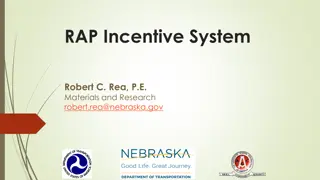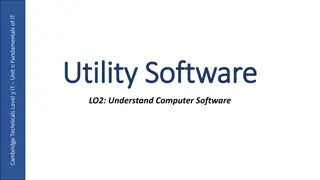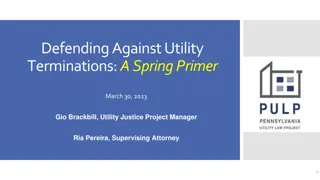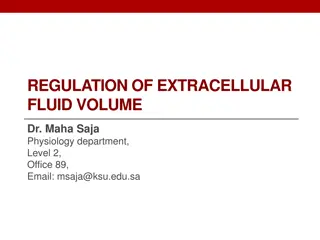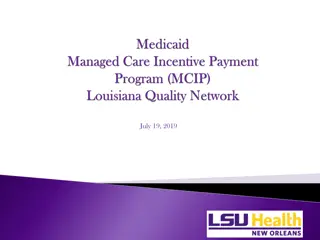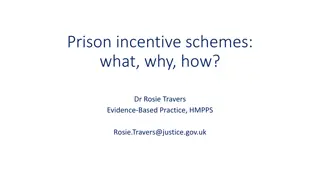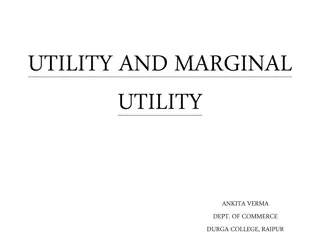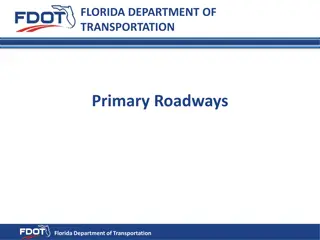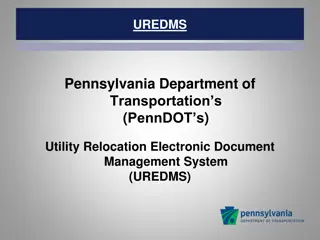Understanding Incentive Regulation in Utility Management
Incentive regulation in utility management involves various approaches such as Rate of Return Regulation (RORR), Price Cap Regulation, and Performance-based Regulation. Each method has its pros and cons, requiring careful consideration based on the specific setting. Rate hearings are essential quasi-judicial processes determining authorized revenue levels. Criticisms of RORR include potential overcapitalization issues and regulatory lag inhibiting innovation in cost reduction. Prudence reviews aim to prevent overcapitalization, but may also hinder efficient capital investment.
Download Presentation

Please find below an Image/Link to download the presentation.
The content on the website is provided AS IS for your information and personal use only. It may not be sold, licensed, or shared on other websites without obtaining consent from the author. Download presentation by click this link. If you encounter any issues during the download, it is possible that the publisher has removed the file from their server.
E N D
Presentation Transcript
Chapter 13 Incentive Regulation
Vocabulary Incentive regulation Rate of return regulation (RORR) Price cap regulation Performance based regulation There is no single regulatory plan or policy that works in every setting
Traditional Rate of Return Regulation RORR seeks to provide a normal profit (and only a normal profit) for the regulated enterprise A firm s costs are measured under RORR through total costs, operation expenses, and capital costs Review the equation for RORR
Rate Hearings A rate hearing is a quasi-judicial process in which evidence is put forth to determine the firm s costs and thus an appropriate level of authorized revenue At a typical rate hearing, the regulatory commission reviews evidence presented by the firm, by customer representatives, and by the commission s staff Because the issues addressed at a rate hearing can be complex, hearings typically take months to conduct
Averch-Johnson Effect RORR has been criticized that it may induce the regulated firm to employ too much capital and too little noncapital inputs and thereby operate with inefficiently high production costs Consider an analysis that reflects the work of Harvey Averch and Leland Johnson Overcapitalization
Averch-Johnson Effect versus Least-Cost Production
Prudence Reviews and Cost Disallowances Regulators attempt to limit overcapitalization in part by conducting prudence reviews Consider the investments in nuclear power plants in the 1970s as an example The prospect of being unable to recover the cost of investments may help to deter overcapitalization, but it could also discourage efficient capital investment
Regulatory Lag RORR has also been criticized on the grounds that it provides the regulated firm with limited incentive to discover innovative ways to reduce its operating costs Explain how regulatory lag can provide some incentives for cost reduction under RORR
Incentive Regulation Price Cap Regulation Price cap regulation (PCR): a form of incentive regulation suggested by Stephen Littlechild in the early 1980s Vocabulary Price cap period X factor PCR institutionalizes the regulatory lag that provided some incentive for cost reduction under RORR and by implementing a fairly long price cap period, regulators can provide relatively strong incentives for cost reduction under PCR
Price Cap Regulation Pricing flexibility Cream-skimming: a process whereby new industry suppliers offer only the most profitable services and leave incumbent suppliers to deliver less profitable services Consider an example where excessive pricing flexibility can discourage industry entry List the three steps of the PRC plan after it distinguishes between services for which the incumbent supplier faces no competition and those for which competition is beginning to emerge
Price Cap Regulation Z factors Many PCR plans allow prices to be revised during the price cap regime to reflect the financial implications of major, unanticipated industry events List the three requirements to qualify for a Z factor adjustment Z factors can help ensure that the regulated firm is held responsible for its performance on dimensions that it can control and is not held responsible for its performance on dimensions that it cannot control Z factors can also be implemented in the form of automatic adjustments in authorized retail prices as uncontrollable wholesale prices change
Price Cap Regulation Earnings variation PCR can admit very high or very low earnings for the regulated firm Consider the example case in the UK involving the PCR imposition on British Telecom beginning in 1984
Earnings Sharing Earnings sharing regulation (ESR) is similar to PCR except explicit limits on realized earnings are announced in advance Consider the example involving the California Public Utilities Commission (CPUC) and the telecommunications supplier Pacific Bell ESR has its advantages and disadvantages Review the adoption of RORR, PCR, and ESR by state regulators between 1985 and 2007
Earnings Sharing Service quality A potential drawback to PCR is that it can reduce a firm s incentive to deliver high- quality service to its customers Reducing service quality is one way to reduce costs It can be difficult to identify in complete detail and measure accurately all relevant dimensions of service quality
Performance Based Regulation in the Electricity Sector Various alternatives to RORR often referred to as performance based regulation (PBR) have been adopted in the electricity sector Many PBR plans identify particularly important dimensions of service quality and link financial rewards and penalties to realized performance on the identified dimensions The Office of Electricity Regulation introduced RIIO: Revenue = Incentives + Innovation + Outputs
Regulatory Options Sometimes consumers can be better served if the regulated supplier is afforded a choice among regulatory plans Consider a setting that functions to explain the value of allowing the regulated firm to choose one plan from a carefully designed set of regulatory plans The regional Bell operating companies (RBOCs) have been afforded a choice among regulatory plans by the FCC
Yardstick Regulation Regulators can employ an alternative form of incentive regulation when they oversee multiple firms that operate in distinct geographic regions Yardstick (or benchmark) regulation has intuitive appeal, but, when implemented, it can encounter serious problems Firms seldom operate under identical circumstances, which can impose financial hardships on firms that face high operating costs Benchmark regulation typically does not provide a simple resolution to difficult problems that regulators face when attempting to motivate suppliers to operate efficiently and to deliver high-quality services to customers at low prices
Summary This chapter has: Reviewed the key elements of rate of return regulation (RORR) and discussed some of its potential drawbacks Reviewed several possible alternatives to RORR and explored their primary advantages and disadvantages Noted that a regulator can sometimes serve consumers well by affording the regulated firm a choice among a carefully designed set of regulatory options Shown that no regulatory plan is ideal in all respects, and the best choice of regulatory plan varies with the prevailing environment and regulatory goals


